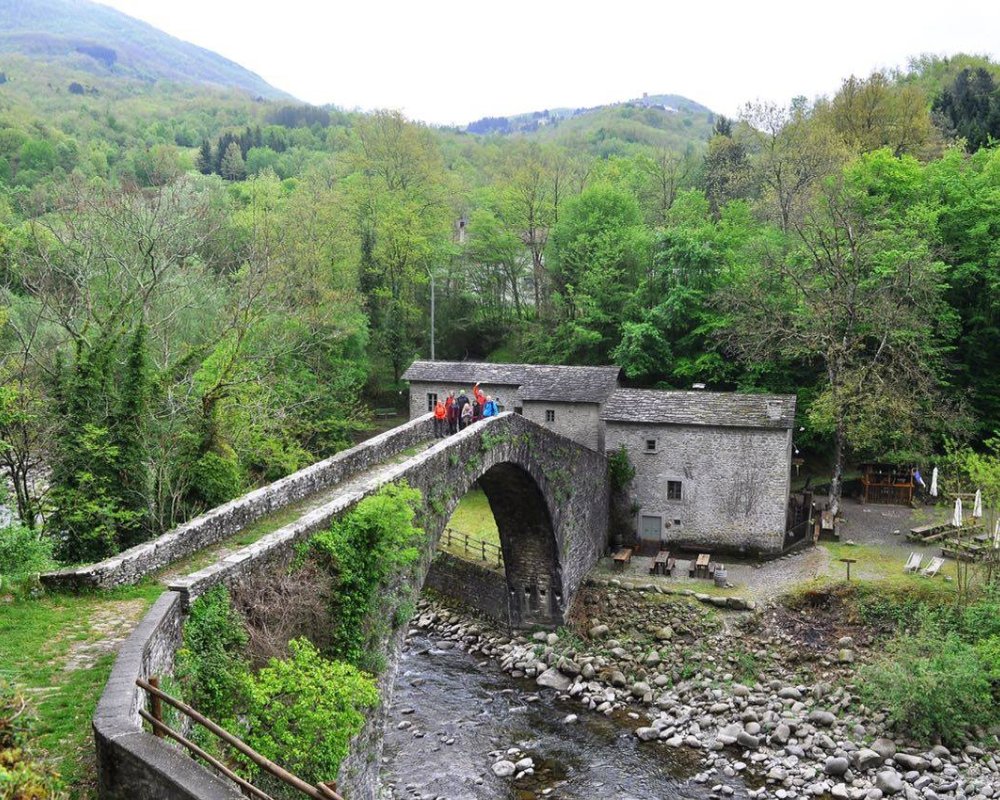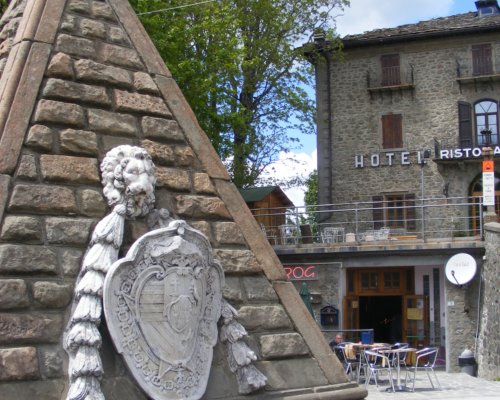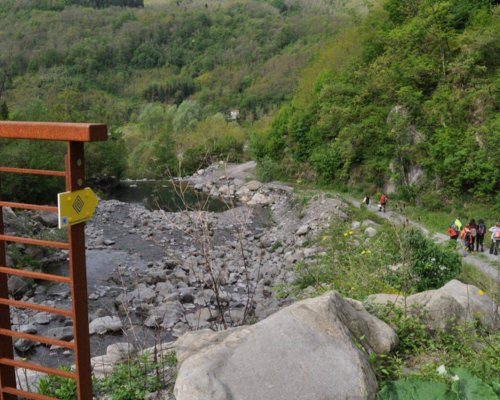A devotional journey that rolls from Emilia-Romagna into Tuscany
Tuscany is bisected by the Via Francigena and other well-known pilgrimage routes, but there is space enough also for the Cammino di San Bartolomeo, a 100km-long devotional trail that connects various places dedicated to the saint. For Saint Bartholomew, one of the twelve apostles, is the patron of many a little town in these parts, such as Cutigliano, and a number of churches and festivals as well
The route begins at Fiumalbo, in the province of Modena, and finishes in Pistoia. It can be divided into five sections, and so should take around five or six days, depending on the fitness of the pilgrim.
The majority of the route is made up of mule tracks and dirt paths, keeping asphalt stretches to a minimum and not causing any great difficulties. The signposting is recognisable by yellow arrows, while the symbol of the route is the so-called borlengo, fashioned either from stone or wood.
The Cammino di San Bartomoleo passes through areas of especial natural beauty, which often as not are home to historic and artistic gems. It is, therefore, a perfect walk for those who are looking for silence, reflection and inner peace.
The Cammino di San Bartolomeo starts at Fiumalbo and kicks off in the direction of Abetone and Rivoreta, a little town at the foot of the mountain known as the Libro Aperto (open book). Rivoreta is home to the interesting Museo della Gente dell’Appennino Pistoiese (museum of the people of the Pistoiese Apennines, which forms part of Ecomuseum of the Pistoiese Mountains complex). You then arrive at Cutigliano, where you can visit the parish church of San Bartolomeo.
The Cammino di San Bartolomeo starts at Fiumalbo and kicks off in the direction of Abetone and Rivoreta, a little town at the foot of the mountain known as the Libro Aperto (open book). Rivoreta is home to the interesting Museo della Gente dell’Appennino Pistoiese (museum of the people of the Pistoiese Apennines, which forms part of Ecomuseum of the Pistoiese Mountains complex). You then arrive at Cutigliano, where you can visit the parish church of San Bartolomeo.
- straighten
Length22,5 km
-
DifficultyAverage
- trending_down
Descent1100 m
- trending_up
Ascent848 m
Leave Cutigliano and descend towards Popiglio, and then towards the old Ponte di Castruccio (Castruccio bridge) and thence to Piteglio. A little further on, at Prunetta, there is an old guest house called the “spedale della Croce Brandelliana”, which used to offer welcome and succour to pilgrims and wanderers.
There is an alternative route from Cutigliano to Piteglio (downloadable here) that goes through Mammiano. Another possibility is the “Porta Lucchese” way, which runs from Popiglio to the village of Vico Pancellorum, before reaching Pieve di Controne, a hamlet of Bagni di Lucca.
Leave Cutigliano and descend towards Popiglio, and then towards the old Ponte di Castruccio (Castruccio bridge) and thence to Piteglio. A little further on, at Prunetta, there is an old guest house called the “spedale della Croce Brandelliana”, which used to offer welcome and succour to pilgrims and wanderers.
There is an alternative route from Cutigliano to Piteglio (downloadable here) that goes through Mammiano. Another possibility is the “Porta Lucchese” way, which runs from Popiglio to the village of Vico Pancellorum, before reaching Pieve di Controne, a hamlet of Bagni di Lucca.
- straighten
Length15,1 km
-
DifficultyAverage
- trending_down
Descent837 m
- trending_up
Ascent829 m
The way continues through the greenery and woodland of an area much-loved in the summer months. You reach Pontepetri via the hamlet of Le Piastre, where you can see the Madonnina Ice House, an eighteenth-century structure that was used to keep ice frozen.
Again, there is an alternative route (downloadable here), which links San Marcello Pistoiese (an area famous for its suspension bridge, which connects Mammiano Basso with Popiglio), Gavinana and Maresca (where you can still visit the Papini Foundry). The final leg of this section takes you from Campo Tizzoro to Pontepetri.
The way continues through the greenery and woodland of an area much-loved in the summer months. You reach Pontepetri via the hamlet of Le Piastre, where you can see the Madonnina Ice House, an eighteenth-century structure that was used to keep ice frozen.
Again, there is an alternative route (downloadable here), which links San Marcello Pistoiese (an area famous for its suspension bridge, which connects Mammiano Basso with Popiglio), Gavinana and Maresca (where you can still visit the Papini Foundry). The final leg of this section takes you from Campo Tizzoro to Pontepetri.
- straighten
Length19,2 km
-
DifficultyAverage
- trending_down
Descent426 m
- trending_up
Ascent416 m
The next destination, Spedaletto, is a little mountain village in the municipality of Pistoia. Its name comes from the guest house, the Pratum Episcopi hospice, that has stood there since at least 1090 for the reception of pilgrims and wayfarers. The church of San Bartolomeo and its beautiful bell tower are what remain of the original complex.
The next destination, Spedaletto, is a little mountain village in the municipality of Pistoia. Its name comes from the guest house, the Pratum Episcopi hospice, that has stood there since at least 1090 for the reception of pilgrims and wayfarers. The church of San Bartolomeo and its beautiful bell tower are what remain of the original complex.
- straighten
Length10,8 km
-
DifficultyAverage
- trending_down
Descent341 m
- trending_up
Ascent441 m
The final stretch goes through Baggio and concludes in Pistoia, at the church of San Bartolomeo in Pantano. The pattern on the church’s frieze inspired the logo of the pilgrimage route.
In Pistoia, as in the Pistoiese mountains, the cult of San Bartolomeo is especially strong and heartfelt. Saint Bartholomew is considered the patron saint of children, who receive a blessing at religious services on 24 August. The typical sweet eaten that day in Pistoia is the “pippi” or corona (crown) di San Bartolomeo, a traditional necklace of sweets, chocolates and chunky biscuits, strung out along a length of twine. Even today, as in the past, the children carry these crowns of San Bartolomeo around their necks.
The final stretch goes through Baggio and concludes in Pistoia, at the church of San Bartolomeo in Pantano. The pattern on the church’s frieze inspired the logo of the pilgrimage route.
In Pistoia, as in the Pistoiese mountains, the cult of San Bartolomeo is especially strong and heartfelt. Saint Bartholomew is considered the patron saint of children, who receive a blessing at religious services on 24 August. The typical sweet eaten that day in Pistoia is the “pippi” or corona (crown) di San Bartolomeo, a traditional necklace of sweets, chocolates and chunky biscuits, strung out along a length of twine. Even today, as in the past, the children carry these crowns of San Bartolomeo around their necks.
- straighten
Length24,1 km
-
DifficultyAverage
- trending_down
Descent1124 m
- trending_up
Ascent424 m


